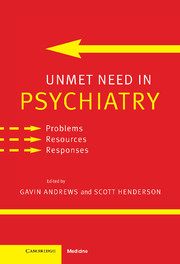Book contents
- Frontmatter
- Contents
- List of Contributors
- Preface
- Part I Unmet need: defining the problem
- Part II Unmet need: general problems and solutions
- Part III Unmet need: people with specific disorders
- Part IV Unmet need: specific issues
- Introduction
- 22 Unmet need in mental health service delivery: children and adolescents
- 23 Assessing psychopathology among children aged four to eight
- 24 Unmet need in Indigenous mental health: where to start?
- 25 Health systems research: a pragmatic model for meeting mental health needs in low-income countries
- 26 Disablement associated with chronic psychosis as seen by two groups of key informants: patients and mental health professionals
- 27 The assessment of perceived need
- 28 Public knowledge of and attitudes to mental disorders: a limiting factor in the optimal use of treatment services
- Part V Unmet need: conclusion
- Index
Introduction
from Part IV - Unmet need: specific issues
Published online by Cambridge University Press: 21 August 2009
- Frontmatter
- Contents
- List of Contributors
- Preface
- Part I Unmet need: defining the problem
- Part II Unmet need: general problems and solutions
- Part III Unmet need: people with specific disorders
- Part IV Unmet need: specific issues
- Introduction
- 22 Unmet need in mental health service delivery: children and adolescents
- 23 Assessing psychopathology among children aged four to eight
- 24 Unmet need in Indigenous mental health: where to start?
- 25 Health systems research: a pragmatic model for meeting mental health needs in low-income countries
- 26 Disablement associated with chronic psychosis as seen by two groups of key informants: patients and mental health professionals
- 27 The assessment of perceived need
- 28 Public knowledge of and attitudes to mental disorders: a limiting factor in the optimal use of treatment services
- Part V Unmet need: conclusion
- Index
Summary
The unmet needs of specific groups
Some groups in the human population have greater unmet needs than others – and some lesser. In this penultimate section of the book, our contributors look at this issue. Sawyer and Patton (Chapter 22), then Cottler et al. (Chapter 23) consider the situation for children and young people. Hunter (Chapter 24) spells out the social disaster caused by European contact for indigenous or Aboriginal Australians after some 60,000 years presence in Australia. Then Patel (Chapter 25) reminds us of the situation for the majority of people today – those living in low-income countries. We could continue to list specific groups. Our book would then have covered the elderly, women, migrants, refugees, the poor, those in war zones, those afflicted by natural disasters, and many more who are disadvantaged and have poor health. Since the list is endless, we urge the reader to consider the deeper principles that can be discerned in the contributions by Sawyer and Patton, Cottler et al., Hunter, and by Patel. Along with the preceding chapters, these help to set the agenda for answering that awesome question, ‘what is to be done?’
Sawyer and Patton see three complementary tasks: how to identify the needs of children; what treatments are available and effective; and, lastly, what can be done to prevent childhood mental disorders. Readers should remember that some remarkable claims are currently being made about the effect of group interventions for young people in schools (e.g., Kellam & Anthony, 1998; Kellam, Mayer, Rebok, & Hawkins, 1998).
- Type
- Chapter
- Information
- Unmet Need in PsychiatryProblems, Resources, Responses, pp. 327 - 329Publisher: Cambridge University PressPrint publication year: 2000



